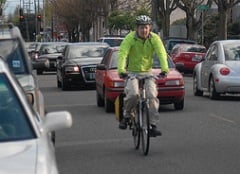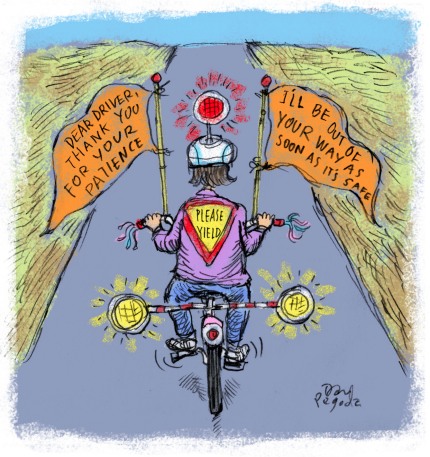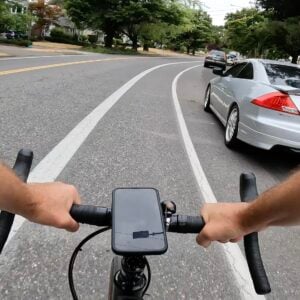
(Photos © J. Maus)
Many of you already know that you have the legal right to “take the lane” when necessary. What’s less understood is what this actually means, both in practice on the road and in the law.
“Take the lane” is a common phrase, almost a rallying cry in some circles, and it’s used throughout the country. For many people, it’s the catch-all term that explains how bicycles are allowed to legally use the roadway; but what does it mean in Oregon?
For starters, “take the lane” doesn’t even exist in the Oregon Revised Statutes (ORS). So, does it mean a person riding a bike should literally take up the entire lane, riding wherever he/she chooses? Or are you legally allowed just a portion of the road?
It depends.

What the ORS does say (in 814.430) is that a person operating a bike has the right to move away from the far right side of the roadway (or left side on a one-way street),
“when reasonably necessary to avoid hazardous conditions… Or other conditions that make continued operation along the right curb or edge unsafe or to avoid unsafe operation in a lane on the roadway that is too narrow for a bicycle and vehicle to travel safely side by side…”
For many people, few bike riding maneuvers are more heart-pounding and sweaty-palm inducing than placing yourself in a lane with motor vehicles breathing down your neck. Yet this is precisely what you must do on narrow roadways without an existing, usable or safe bike lane (in Portland, think of NE Ainsworth and sections of many streets in commercial districts).
If it makes you feel any better, moving into the lane is sanctioned by Oregon law. The ORS (full text of the law here) gives you a degree of freedom to determine what it means to operate your vehicle (bicycle) safely on the roadway given the condition of the road, its lane width, speed limit, traffic volume, parking and even the weather. All these factors are also open to the interpretation of police officers, judges and the other traffic behind you.
It may seem like a lot to think about, but here it is in a nutshell…
Every bicycle operator has the legal right and responsibility to take a reasonable use of the roadway in order to protect their own safety. You may take as much of the lane as is practically prudent to create a safe space all around you.
Hopefully now you’ve got a better understanding of the practical and legal implications of “take the lane”. Just rememeber, like many Oregon laws that pertain to bikes, what is “reasonable” and “prudent” is open to interpretation.
— Bike Law 101 appears twice a month thanks to the generous support of West End Bikes PDX (corner of 11th and SW Stark in downtown Portland). It’s written by Karen Lally and Kurt Jansen of the non-profit Animated Traffic Law Center based in Eugene, Oregon. For more info on bike law, browse the Bike Law 101 archives







Thanks for reading.
BikePortland has served this community with independent community journalism since 2005. We rely on subscriptions from readers like you to survive. Your financial support is vital in keeping this valuable resource alive and well.
Please subscribe today to strengthen and expand our work.
If you’ve ever taken a motorcycle operator class, you know that ‘taking the lane’ also means controlling the lane, so that motorists behind you don’t attempt to ‘share the lane’ with you while you are in it.
This means that if you do ‘take the lane’ you need to do it in a way that leaves no doubt that motorists behind you need to slow down and change lanes to pass, which generally means riding in a center-left lane position, and not just riding in the right hand wheel track, as the latter tends to encourage unsafe passing.
as such, the lane position shown in the accompanying photograph is really not the proper lane position to be in while taking the lane.
I would argue that, in balancing personal safety with sharing the road with others, the guy in the picture is in a good spot. He has made it slightly easier for drivers behind to pass him – they can pass by somewhat in the middle of the road and still give the bike rider four feet of cushion. Further, the bike rider has plenty of cushion on his right to shift over some if a passing driver comes too close. If the bike rider were in the left of his lane, most drivers would pass much closer to him because it is a narrow street and they would want to avoid being too close to the opposing parked cars – where someone can step out at any moment.
But every situation is different, and that is just one picture.
Cyclist in photo is still inside the door zone of the average American car by about 3″-6″ and by up to 1 to FEET for larger F150, F350, Escalade and Hummer wannabe vehicles.
The law tells me not to swerve in and out of on-street parked autos and that I must travel outside of the door zone. This is easily the width of a full bike lane sandwiched between on street parking and an auto lane and could be an extra 2-3 feet past that.
After all that we can talk about sharing the lane.
Just as a data point, an F150 door opens to a point about 40 inches (3′ 4″) beyond the side of the vehicle, or 30 inches (2′ 6″) beyond the mirror (measured).
If a bike/rider is 20″ wide (pretty narrow, many of us are wider), that’s 10″ on each side of a perfectly straight tire track (nigh impossible).
So, riding a line 50″ (4′ 2″) to the side of an F150 will give a skinny bike/rider combo zero clearance in passing if the door opened all the way.
Allowing a little margin for passing clearance, a bit wider rider and knowledge that keeping within even a 12″ tire track for much distance is challenging, it seems like I should be staying about six feet (72″) away from the side of parked vehicles. Does that make sense in the experience of others?
The perspective could be skewed, but the tire track of that red car is probably very close to exactly five feet. Based on that, I would say the bike is four feet from the parked cars. Plenty of room, especially since the rider is probably going only ten mph. If he were going 20, then I would say get in the middle of the lane – to have more reaction time to any cars or people jumping out from the side.
Exactly. Too many people perform what I call the “meat-grinder maneuver.”
Some even pass cars on the right side in a space less than 2 1/2 feet. Happens all day long on SE 28th Ave near the Goodfoot.
Good point about riding in the wheel tracks, too. The center grease stripe is slippery.
Thanks for this Animated. What about how 814.430 juxtaposes with 811.425? My read is that cyclists may certainly take the lane but they must yield to overtaking vehicles following the speed limit when safe to do so. This is true if they are on a two-way, two-lane roadway (i.e. one lane in each direction) and there is no clear lane for passing (as with a dashed centerline stripe). In other words, to be legal you must also be respectful and let overtaking vehicles pass when it’s safe to do so.
811.425 doesn’t apply when riding a bicycle…
http://www.stc-law.com/slowmoving.html
that’s one argument. if there is a reasonable gap and you don’t move over to let motorists pass, you are at least being ungracious. ray thomas does not argue otherwise in the link you provide, and in fact he frames the argument with the extreme example of a narrow road with no turnouts, where the overtaking motorist is dragging a horse trailer.
Ok. Consider this scenario. A two way, four lane street – two lanes each direction – with a posted speed limit of 35mph and no bike lane. There is not sufficient room for a motor vehicle to pass with six feet of clearance (sorry don’t have the citation for the Safe Passing Law handy) within the lane. Would it be reasonable to assert that the limited passing clearance is a hazard that justifies moving off the right hand edge of the roadway and controlling the lane as BURR describes above?
Describe the shoulder of the road…?
my take is that this is a situation in which you should control the lane and require overtaking motorists to use the left lane. 801.450 says the shoulder is not part of the roadway.
Interesting, yes, it specifically says “exclusive of the shoulder.” And 814.430 (Improper use of lanes) only says “roadway.” Here in WA, shoulders are the correct place in some situations, for example where riding is allowed on freeways.
That must make for some interesting situations, for example Hwy 30 in Linnton. That’s a shoulder but I bet a lot of people ride on it.
here’s the info on the Safe Passing law you were looking for… http://www.stc-law.com/SafePassing.html
If you are operating in a “lane on the roadway that is too narrow for a bicycle and vehicle to travel safely side by side”, then you should be OK to control the lane. I also believe that the definition of “safely” is entirely up to the person with the most to lose, i.e., you, the person on the bike.
My anecdote:
I was harrassed by a police officer in downtown Portland a while back for not taking the bike lane when one was provided. I joined the one way street on the left side and was taking another left in 3 blocks so it did not make sense to go all the way across 3 lanes of traffic to ride in a bike lane for a block or two. The cop was not going to hear anything of it though.
I thought I was allowed whatever lane made the most sense, but was told that I had to ride in the bike lane if one was provided.
See the mandatory sidepath law, ORS 814.420. It should be repealed.
while i often would prefer to take the left lane on a one-way street several blocks before i intend to take a left turn, so that i do not have to fight my way across at the last moment, the fact is that under 814.420 (not mentioned in this article), where a striped lane is provided, you are required to use it, except where you are actually preparing to make a left turn. the question then becomes how early are you permitted to prepare for the left turn? check out
http://bikeportland.org/2006/11/07/expert-witness-backfires-on-da-in-bike-lane-case-2497
also of relevance to this article, the requirement of 814.420 that you use a bike lane where provided will very often put you to the right of what would otherwise be a safe lane position and encourage unsafe passing.
I do the same thing on a few streets out in Beaverton on my way to/from work. I have learned that the easiest time to change lanes, e.g., to “prepare to make a left turn” is when there is a gap in traffic, not when I am within some magic proximity to the turn I need to make. Sometimes this means I am “taking” the lane sooner than some would deem necessary.
I loved the quote from the article linked to by are above: “I gave him the analogy that it’s common for a motor vehicle to merge into the left lane even a mile before they expect to execute their turn.” This is so true. A Driver of a car could be subject to citation for “improper execution of a left turn” if they suddenly swerved across two lanes to make a turn, yet is this what people expect
cyclistspeople on bikes to do? I’ll bet the real answer is that people expectcyclistspeople on bikes to always make “pedestrian” turns, since we ought to be too afraid to cross a “car” lane and are obviously insane for riding a bike in traffic in the first place…‘preparing to make a left turn’ is one of the allowed reasons to leave a marked right-hand bike lane under the mandatory side path law.
If you have to cross three lanes of traffic in order to make the left turn, you are entirely justified in doing so several blocks before the intersection you will be turning at.
The cop was wrong, plain and simple.
You’d be covered by exceptions allowed in the so called ‘mandatory sidepath law’, to stay in the left lane in preparation to make a left turn three blocks ahead. Downtown, 3 blocks would likely have been 600 feet.
The distance it would involve to legally signal in advance of the lane transitions:(thee at 100′ each), and then actually make the transitions, would use up 400′-500′ of the three block distance. To get all the way over to the bike lane from the left lane of say…S.W. Broadway, you’d just be making a big zig-zag, possibly across a lot of traffic. That would make use of the bike lane for your specific travel need, ‘unsafe’.
The cop might have felt certain about conditions provided for in the Oregon laws relating to use of the bike lane by people riding bikes on the road, but it seems to me if you’d had to have a judge sort it out for you, the cop would have been corrected in his assumption about what the law allows for.
You are certainly right about the interpretation of the police and judges. There was a period of time where the police watched the west end of the Hawthorne bridge for westbound riders “taking the lane” and ticketed them on the basis of the bike lane striping making it clear that taking the lane wasn’t necessary. I commute over 5,000 miles per year for the last 10 years and being stuck in that bike lane as 75% of the cars in the right lane merge across your path to turn right at 2nd Ave was the most dangerous thing I did every day. Thank goodness that they don’t seem to interpret it that way any more because I take my lane as soon as I can safely do so. If they change their interpretation, can I have my $200 back?
One of my silly commute goals is to exceed the speed of adjacent motorists in the middle lane as I exit to the left at 12th. I’ve smoked many thousands of motorists!
Could someone please explain to Portland Streetcar why their tracks must not be next to the right curb on one-way streets?
have you looked at the design of a Portland street car? the wheels are recessed a bit. there are also ADA rules in play for wheelchair accessibility.
For good illustrations of “taking the lane” or “claiming the lane”, I highly suggest watching this series of videos on youtube.
http://youtu.be/ZFjCza5e1kw
R
Yes, much. Generously speaking I’m generously sized; realistically speaking I need to walk or bike everywhere to control my width. All that said my panniers are on my bike when ever I’m riding and that width overshadows mine by 50-100%.
I do like being proved right or even wrong with 3rd party verifiable impartial data. My unsubstantiated observations have been of doors on lift kitted SUVs where the door frame has been further modded so that it will open a full 90 degrees. My stereotyping of the drivers of these caricatures of automobiles has shown them to be the type of people that will always fling their vehicle door open as fast as possible and as far as possible without any concern for others.
I do think the worst door width issue I ever saw was off of something that looked like a Lincoln Continental; it seemed like the door stuck out more than half the width of the car.
I picked 20″ wide as a minimum. Double plastic-bucket panniers will make it nearly twice that, or really wide handlebars. The truck door opening is for stock door-stops, yes. I’m sure good riders can stay tighter than 12″. Maybe errors in my guesstimates cancel out, to some degree. But the total I came up with–six feet–seemed surprisingly big. Is that really about the safe range to stay out of the door zone?
When does a vehicle behind me become an “overtaking vehicle”. There is absolutely no way that I can keep track of and classify every vehicle that happens to be behind me.
And I don’t understand the picture that says “This is what not to do.”. I don’t think the article refers to it. It’s just a picture of a white car passing a cyclist.
For some reason car drivers (“people of car” ?) think there is some god-given, constitutional demand that they must pass every cycle right away and as fast as possible no matter what. From a cyclist’s perspective, the concept of “sharing the road” is a complete joke.
Amen. I see this bewildering behavior every day. I can be “taking the lane” and exceeding the speed limit myself (on the right downhill) and drivers will still pass me, sometimes only to slow down and hold me up–as long as they are ahead. This mentality also leads to the statement that I see/hear quite often from the bikes-should-get-off-the-road contingent: “If I have to choose between getting in a head-on with oncoming traffic or running over a cyclist, guess which one I will choose?” Funny that the choice of “staying behind the cyclist until it is safe to pass” is never considered.
Sharing means waiting.
Amen, El Biciclero.
The law even says that you have to wait until the oncoming lane is clear before you can move over to make a pass of a vulnerable road user. What’s so hard about that?? Is waiting the 2 or 3 seconds for a safe time to pass really going to make that big a difference in the overall trip time? (Not hypothetical– I’ve tried unscientifically to quantify it and my answer is “no”, but I’m just one so a poor sample for statistical analysis.)
As a person of car, if I come up on a vulnerable road user I will slow down and hang back until it’s safe to pass. The other people of car behind me don’t appreciate my actions, but I don’t really give a flying hoot about their opinions. I would hope the vulnerable road user appreciates my actions (I know when I’m in that position I do!) and that’s the opinion I value.
I take the lane at every traffic lighted intersection. Also note that 814.420 states that you may claim the lane when:
(e) Continuing straight at an intersection where the bicycle lane or path is to the right of a lane from which a motor vehicle must turn right.
How many ‘right hook’ accidents would be avoided if bikes were more assertive at the intersection?
plus one. several further points here.
1. PBoT continues to stripe bike lanes to the right of forced right turn lanes.
2. right hooks can also occur where the bike lane is striped to the right of a lane from which a motorist is permitted but not required to turn right.
3. i will not use a striped bike lane in either situation, but will assert the through lane, even if (as on broadway approaching williams) i have to cross two lanes to do it.
I agree this is safer behavior, just be aware that it is not legal unless the bike line is really painted to the right of a right-turn-only lane. If car traffic is merely permitted to turn right, you have no legal excuse for leaving the bike lane.
i do understand that, but i am not waiting for a legal excuse to do what i have to do to maintain my safety.
Ditto; I’m mostly just sideways-whining about the legal paradox of having to choose between safe or legal.
All but a few roads have lanes that are not “too narrow for a bicycle and vehicle to travel safely side by side…”” Even if the vehicle is only 7 feet wide (including mirrors), and the cyclist is about 2′, if you assume 3′ between, and both the car and the bicyclist are only 1′ from the respective edge of the lane, you have 1 + 7 + 3 + 2 + 1 = 14′. How many roads have lanes that are 14′ feet or more? A few do, for sure, but they’re pretty rare. That means bicyclists can legally take the lane on the vast majority of roads.